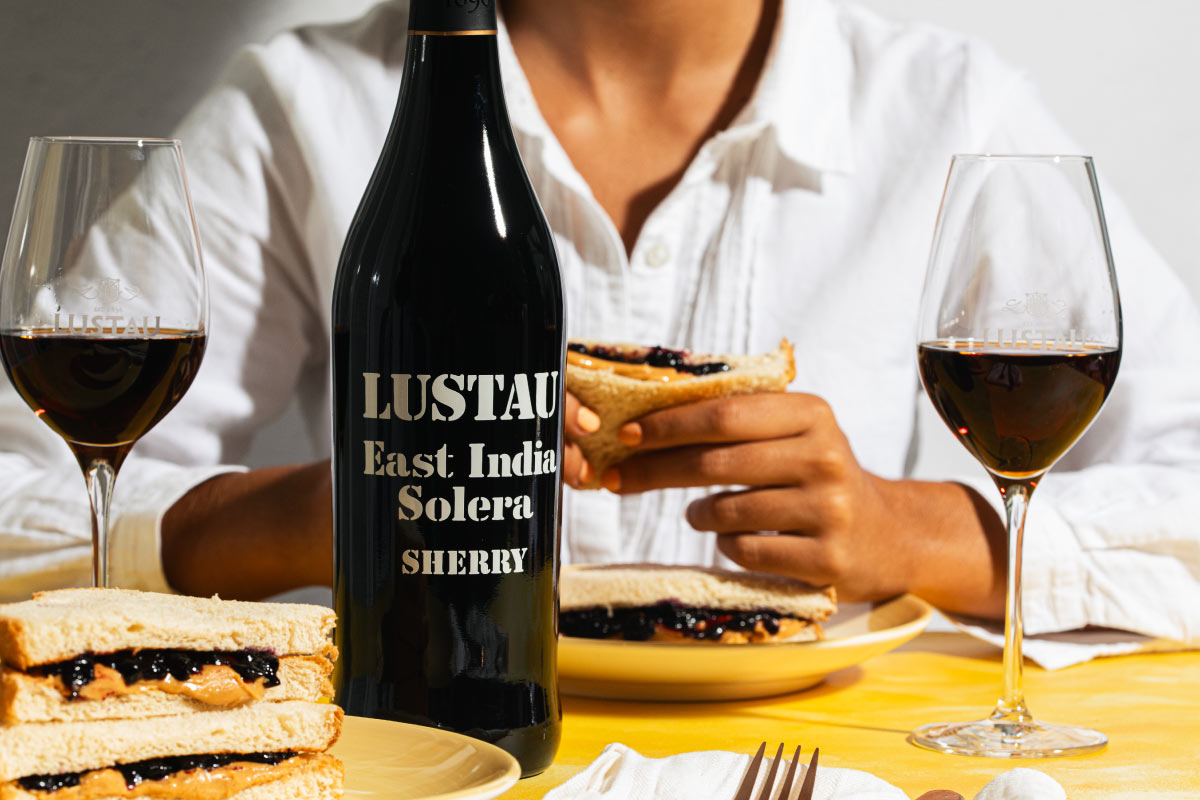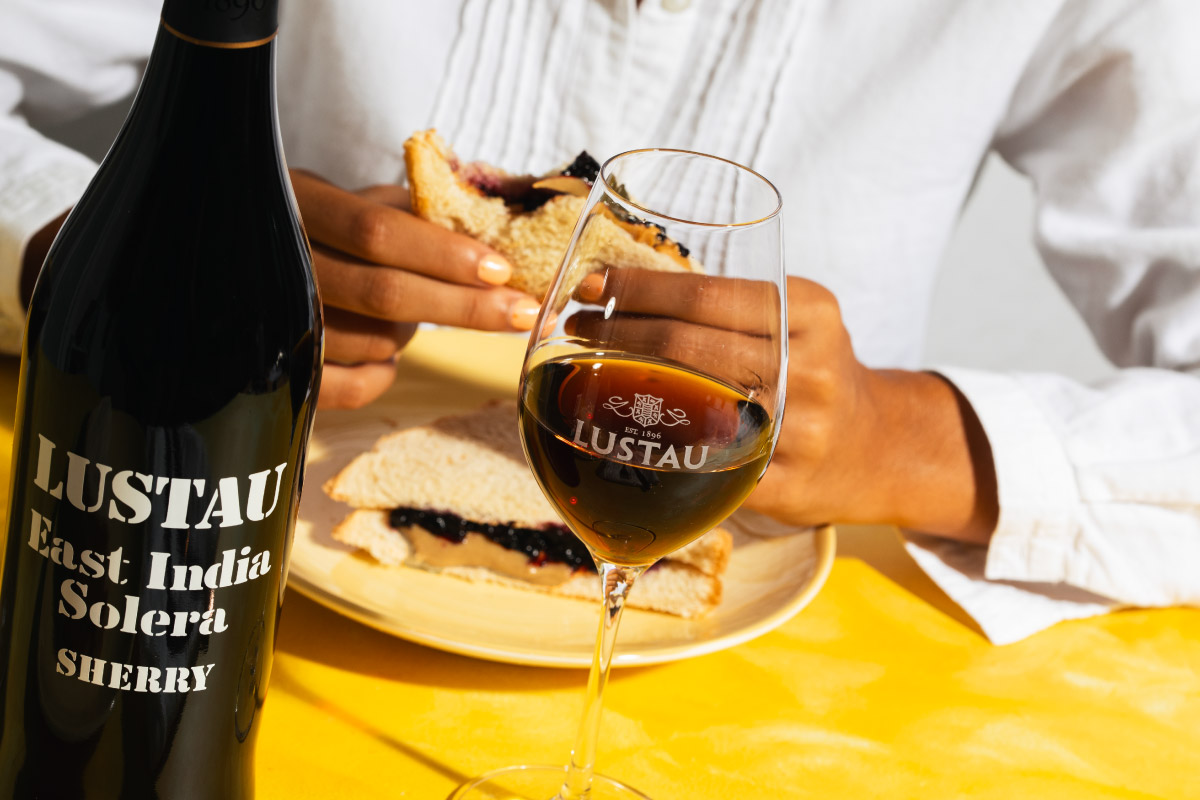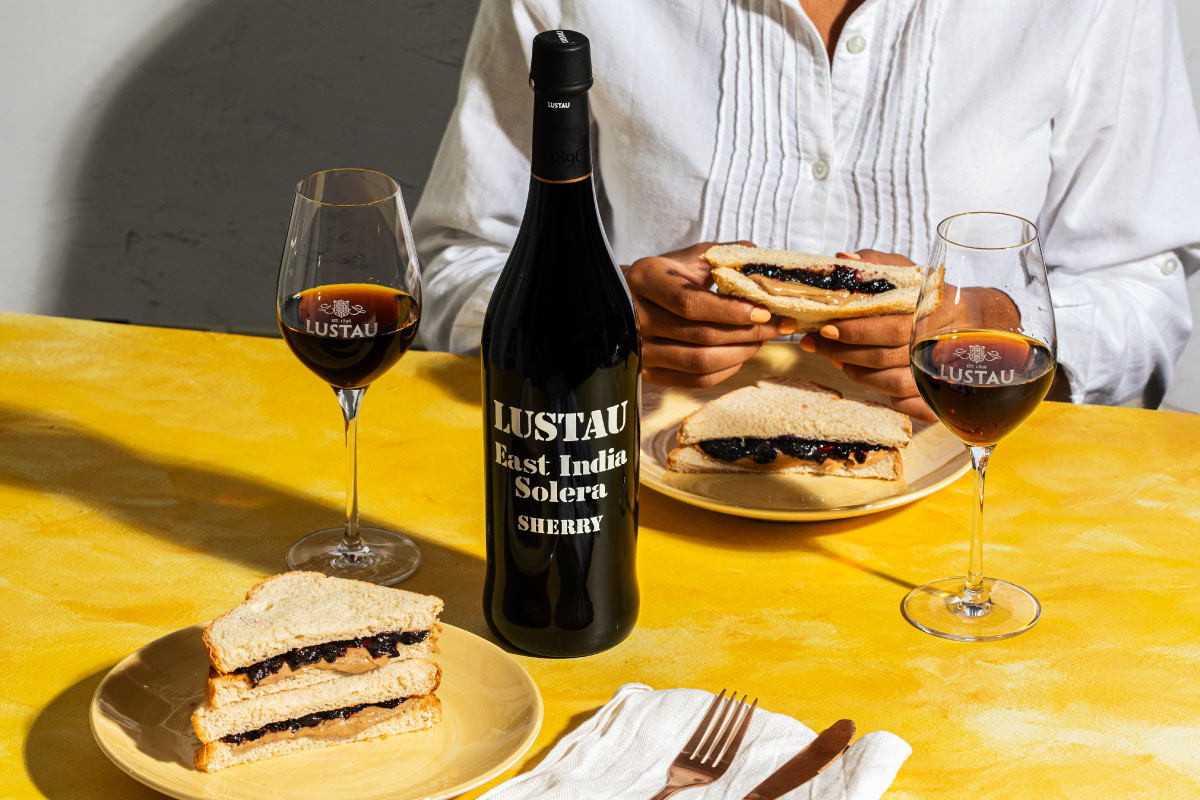Few food pairings surprise and delight quite like the nostalgic charm of a peanut butter and jelly sandwich paired with a glass of sherry wine. At first glance, this may seem like a mismatch. But bring Lustau East India Solera into the picture, and you’ll uncover a remarkable harmony of salt, sweetness, and soul.
In fact, we’ve already explored how sherry enhances peanut butter’s roasted depth in our cookie pairing feature. Now, we’re taking it one step further — from childhood treat to grown-up revelation — with a comfort classic that’s unexpectedly refined.
Whether you’re a sherry explorer or just looking to elevate an everyday favorite, this guide will show you how and why PB&J works with one of Jerez’s most velvety wines. Let’s break it down.

WHAT IS A PEANUT BUTTER & JELLY SANDWICH?
At its core, the peanut butter and jelly sandwich is the ultimate sweet-and-savory comfort food. Two slices of bread, a thick smear of peanut butter, and a bright swipe of fruit jam—each bite balances creaminess, salt, sweetness, and acidity. It’s familiar, filling, and emotionally charged, tapping into early memories for many Americans while continuing to evolve in modern kitchens.
But what happens when this sandwich meets the world of wine? As it turns out, a lot. Especially when that wine is a luscious, complex wine with roasted and fruity undertones of its own.
THE ALL-AMERICAN ORIGINS OF PB&J
Few foods are as culturally iconic as the peanut butter and jelly sandwich. Its roots stretch back to the early 20th century, when peanut butter—once a delicacy for the wealthy—became widely available thanks to industrial processing. Around the same time, sliced bread hit supermarket shelves, and inexpensive fruit preserves became pantry staples. By the 1940s, PB&J had found its way into U.S. military rations during World War II, beloved for being cheap, portable, and satisfying.
After the war, returning soldiers brought their taste for it home. From there, it became a lunchbox fixture, deeply woven into American childhood. Today, PB&J stands as both a culinary time capsule and a canvas for playful reinvention.
WHY PEANUT BUTTER AND JAM CREATE THE PERFECT SWEET-SAVORY DUO
The enduring charm of a PB&J comes from its sensory contrast — a blend of comfort and unexpected sophistication. Peanut butter is dense and mouth-coating, with its rich fats and roasted notes offering umami-like depth. Jelly or jam, on the other hand, delivers brightness through fruit acidity and sweetness — often from grapes, strawberries, or raspberries — that lifts and balances the savory weight of the spread.
This interplay mimics the logic behind great culinary pairings: salty and sweet, creamy and tart, nutty and fruity. The result is a layered mouthfeel and flavor arc that keeps each bite compelling. It’s no wonder the PB&J endures beyond childhood — it satisfies primal cravings while offering room for creative variation.
WHY LUSTAU EAST INDIA SOLERA IS THE PERFECT MATCH FOR PB&J
From a pairing standpoint, this makes it a natural companion for a fortified wine like Lustau East India Solera. This cream sherry mirrors the sandwich’s personality: the oxidative depth of oloroso resonates with the toasted richness of the peanuts, while the sweetness from pedro ximénez grape must complements fruit preserves with warmth and spice. In this way, the PB&J becomes more than a snack — it becomes a launchpad for culinary exploration, grounded in the timeless magic of contrast and harmony.

THE BEST SHERRY FOR SALTY-SWEET COMFORT FOODS
Lustau East India Solera occupies a unique place in the sherry universe. A blend of oloroso and pedro ximénez, aged in a humid microclimate inspired by the historical ship voyages to the East Indies, this wine is gently sweet yet structured — ideal for comforting pairings. Its toasty, nutty tones echo roasted peanuts, while its mellow sugar content is perfectly pitched to avoid overwhelming the jam’s fruitiness. Compared to a classic cream, East India Solera feels sleeker and more gastronomically versatile, especially when it comes to salty-sweet combinations like PB&J.
Here’s some ideas of Lustau East India’s culinary versatility:
HOW EAST INDIA SOLERA ADDS WARMTH, DEPTH, AND A SILKIER FINISH
There’s a plushness to this wine that elevates the texture of each bite. The interplay of dried fig, cocoa, toasted nuts, and baking spices creates a finish that feels like a warm hug — enveloping the palate without dominating it. Lustau East India Solera doesn’t just match the PB&J’s ingredients one by one; it melds them together, smoothing transitions and deepening the flavor conversation. The result is a sensory experience that’s nostalgic, yes — but also surprisingly refined.
HOW TO MAKE THE PERFECT PEANUT BUTTER & JELLY SANDWICH AT HOME
Despite its simplicity, a great PB&J is more than the sum of its parts. The bread provides structure and contrast, the peanut butter lends creamy heft and savory depth, and the jelly adds brightness, sweetness, and a touch of acidity. When assembled thoughtfully, it becomes a timeless expression of comfort food—one that also happens to be a stellar pairing partner for Lustau East India Solera.
ESSENTIAL INGREDIENTS FOR A LEGENDARY PB&J
A great peanut butter and jelly sandwich begins with restraint — and quality. Soft white or whole wheat sandwich bread offers the ideal balance of tenderness and structure, allowing the fillings to shine. The peanut butter should be rich and creamy, with just enough salt to lift the flavor without overwhelming it. Natural styles work best here, particularly those made with only roasted peanuts and minimal added sugar. For the jelly, go with a fruit-forward preserve: Concord grape, raspberry, or strawberry are the classics — sweet, slightly tart, and silky in texture.
Proportion matters, too. Generously spread but not overloaded, each layer should glide onto the bread with ease and meet in the middle for a balanced bite. When the ingredients are well chosen and thoughtfully applied, this humble sandwich becomes a comforting study in contrast: nutty and fruity, salty and sweet, rich and bright.
STEP-BY-STEP GUIDE TO THE PERFECT LAYERING
The art of making a PB&J lies in balance—not just of flavor, but of texture and symmetry. Here’s how to construct it for maximum enjoyment, especially when pairing with Lustau East India Solera:
1. Start with evenly sliced bread. If using sourdough or rustic loaf, lightly toast to awaken nutty, caramelized notes that mirror the sherry’s oxidative depth.
2. Spread the peanut butter first. Room-temperature peanut butter will glide more easily and form a creamy foundation. Apply generously, but don’t overwhelm.
3. Follow with the jam or preserves. Spoon and spread gently to avoid tearing the bread. Aim for even coverage and just enough to offer a sweet counterpoint.
4. Press gently to seal. The ideal PB&J has some give, but holds its shape—creating a satisfying bite with just a hint of stickiness and a clean finish.
5. Optional: slice diagonally. Not essential, but somehow it always feels more inviting—and visually highlights the sandwich’s jewel-toned center.

SHERRY-DRIVEN TWEAKS: HOW TO REFINE YOUR PB&J
To elevate your PB&J into pairing territory with Lustau East India Solera , consider gentle tweaks that bring the sandwich closer to the sherry’s profile. Swap basic sandwich bread for a plush brioche or toasted milk bread — styles with a hint of sweetness and golden crust that echo the sherry’s caramel tones. Or try thin slices of rustic sourdough to contrast with the wine’s softness, enhancing texture while keeping the center lush.
Crunchy peanut butter adds a layer of tactile complexity, while nut butters blended with roasted hazelnuts or almonds can introduce flavors that resonate more deeply with the sherry’s oxidative warmth. On the fruit side, step beyond grape jelly: fig preserves, black cherry compote, or even a swipe of orange marmalade invite deeper aromatic parallels with the pedro ximénez component in the wine.
For a final flourish, a pinch of flaky sea salt or a whisper of cinnamon can tip the experience from nostalgic to transcendent — turning a childhood favorite into a sherry-worthy indulgence.
PAIRING PB&J WITH EAST INDIA SOLERA: A STEP-BY-STEP GUIDE
Pairing a peanut butter and jelly sandwich with Lustau East India Solera Sherry may sound whimsical — but it’s rooted in sensory logic. This guide will walk you through how to elevate this familiar bite into a moment of surprising sophistication.
Step 1: Assemble Your Sandwich Thoughtfully
Start with your refined version: plush brioche or lightly toasted milk bread, smooth or crunchy peanut butter (natural, salted), and a jam or preserve that leans into ripe fruit and gentle acidity — like black cherry, fig, or raspberry. Cut it in halves or triangles, whatever feels nostalgic.
Step 2: Chill or Gently Warm the Sherry
Lustau’s East India Solera is best served just below room temperature — around 12–14°C (54–57°F). Too cold, and you’ll mute its aromatics. Too warm, and it may feel overly sweet or heady. A quick 15-minute chill in the fridge is often enough. Use a white wine or small tulip glass to capture the aromatics fully.
Step 3: Take a Sip Before the Bite
Begin with the sherry. Its aromas of toasted hazelnuts, raisins, toffee, and spice set the stage — priming your palate for the sandwich to come. Notice the richness and smoothness of the wine’s texture: this will soon meet the creamy peanut butter like silk on velvet.
Step 4: Taste Together — and Slowly
Take a bite of the sandwich and let the flavors unfurl — the salt of the nuts, the tang of the fruit, the soft chew of the bread. Then take another sip of the East India Solera. Here’s where the magic happens: the wine’s sweetness cradles the jam, its oxidized notes echo the toast, and its glyceric body tempers the nut’s clinginess. Each returns the other to the palate with added dimension.
FREQUENTLY ASKED QUESTIONS ABOUT PB&J AND SHERRY PAIRINGS
Can I Use Other Sherries with Peanut Butter & Jelly?
Absolutely — but East India Solera hits a sweet spot. Its cream style, combining the oxidative depth of oloroso with the richness of pedro ximénez, makes it uniquely suited to PB&J’s salty-sweet profile. That said, an aged amontillado can offer a drier, nuttier counterpoint (especially if you dial down the jelly), while a young oloroso brings warm spice and savory weight. For more dessert-leaning versions — think chocolate-hazelnut spreads or fig jam — a VORS Pedro Ximénez becomes a decadent match.
Here’s a quick guide to understanding the most exclusive and rarest collection of wines of the region:
Is PB&J Only a Kids’ Snack?
Not anymore. While PB&J may be rooted in playground lunches, its balance of fat, salt, sweetness, and fruit acidity makes it a remarkably grown-up combination — especially when paired with something as complex as Lustau East India Solera. In fact, it’s exactly the kind of nostalgic comfort that modern food and wine culture loves to revisit with fresh eyes and elevated touches. Consider it a perfect bridge between simplicity and sophistication.
What Variations Work Best with East India Solera?
East India Solera thrives with versions that emphasize richness and balance. Opt for darker fruit preserves — blackberry, fig, or cherry — over ultra-sweet grape jelly. Natural peanut butters (with a touch of salt) offer cleaner flavor and better texture than overly processed versions. A nutty multigrain bread will work, but soft brioche or even cinnamon-swirl loaf adds a delightful echo of the wine’s warm spice and toffee notes. Feeling adventurous? Add a sprinkle of sea salt, a sliver of dark chocolate, or a slice of banana — all of which harmonize beautifully with the sherry’s complex sweetness.







